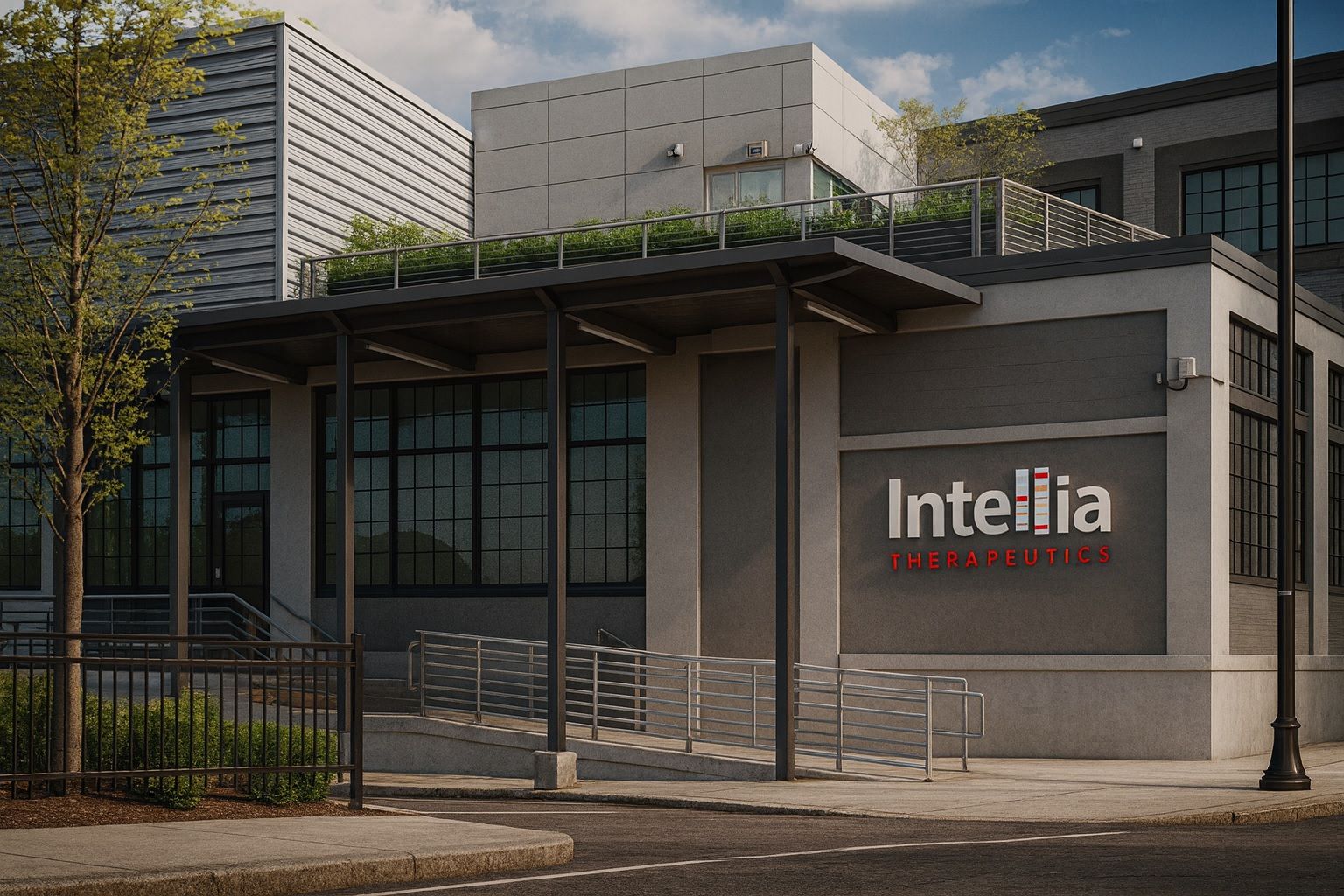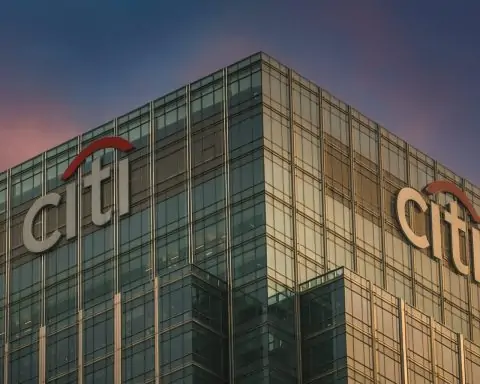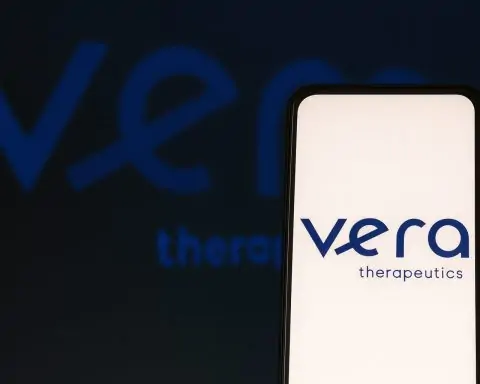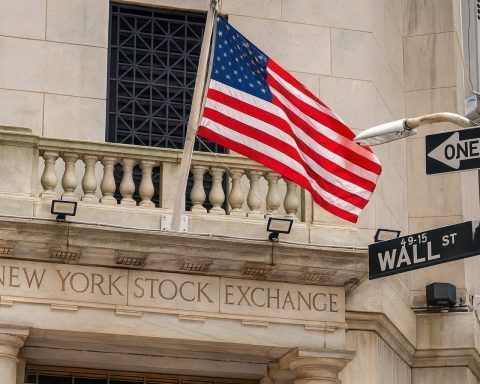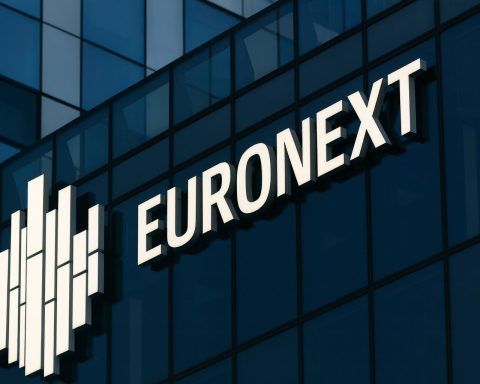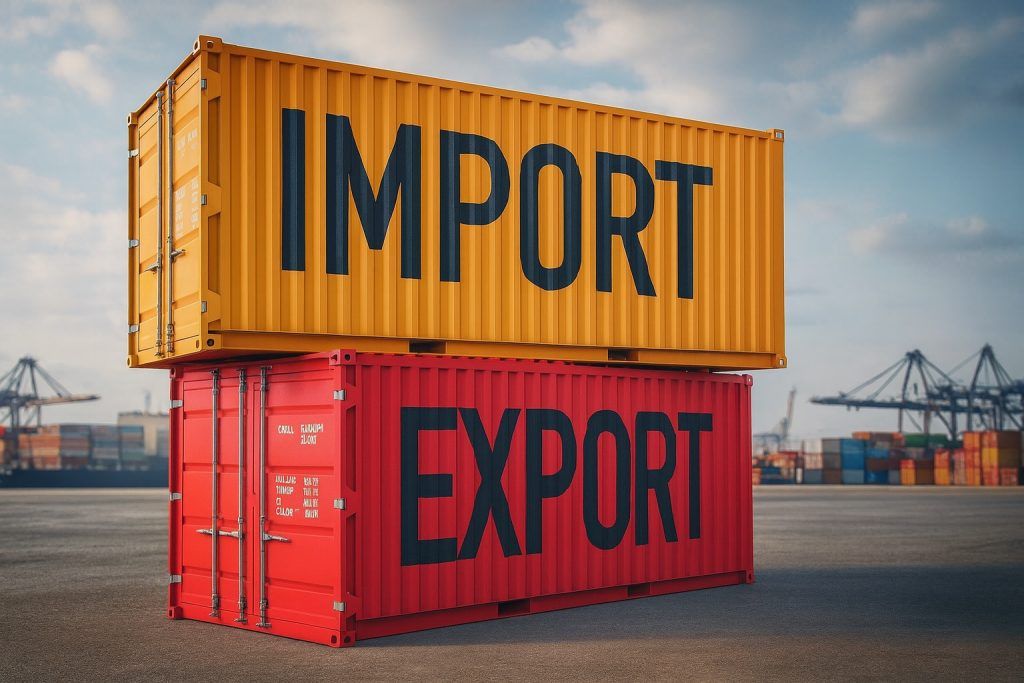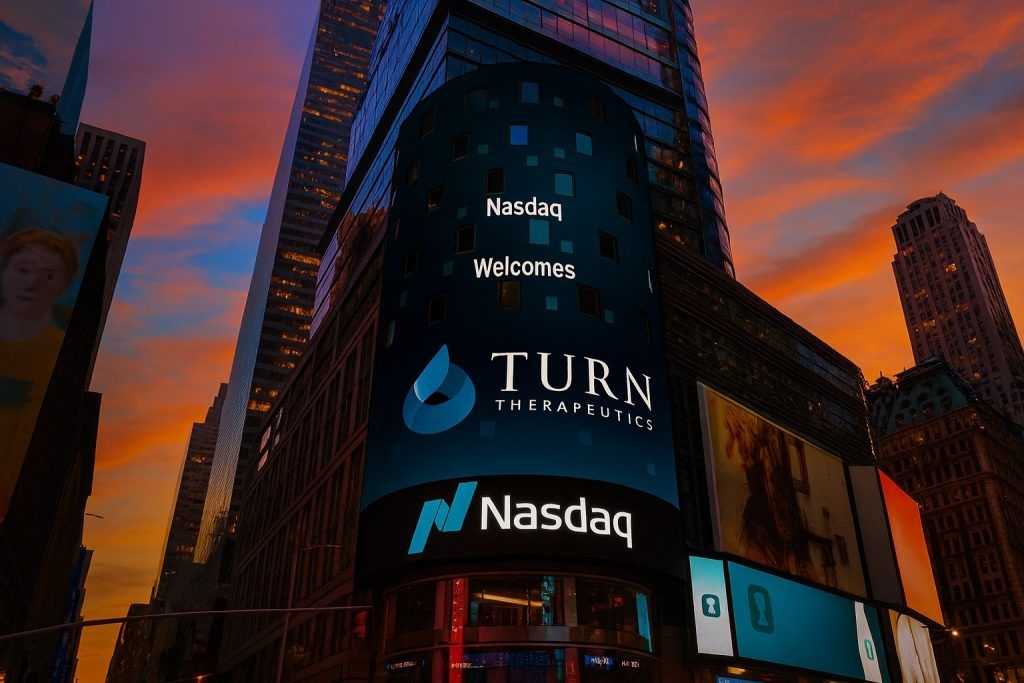- Price Action: NTLA traded in the high teens (~$19–20) in early October 2025 [1], up ~63% year-to-date. After September’s positive trial news, the stock jumped sharply – briefly surpassing $26 on Oct. 8, 2025 (after closing around $20 on Oct. 7) – reaching new multi-year highs. Trading volume has been heavy (e.g. ~17M on Oct. 8) as momentum surged.
- Catalysts: In late Sept. 2025 Intellia unveiled long-term Phase 1 data for its ATTR program (NTLA-2001): a single in-vivo CRISPR dose produced “rapid, deep and durable” reductions in disease protein (TTR) – mean ~90–92% knockdown at 2–3 years [2] [3]. These results (published simultaneously in the NEJM) showed clinical stabilization in most patients and no new safety signals. Simultaneously, Intellia announced full enrollment in its Phase 3 HAELO trial (NTLA-2002) by Sept. 18, 2025 [4] – a 9-month effort to recruit ~60 patients for the hereditary angioedema (HAE) pivotal study. Early data from this program (Phase 1/2) showed ~95–98% reduction in HAE attacks after one dose, bolstering optimism that a one-time gene edit may cure the disease. Overall, “current news flow around early October 2025 is overwhelmingly positive” [5] for Intellia’s CRISPR programs.
- Analyst Consensus: Wall Street is mostly bullish on NTLA. According to TipRanks, 16 of 18 recent analyst ratings are Buy or Strong Buy [6]. The average 12-month price target is ~$31.7 [7], implying ~70–100% upside from the low-$20s price; targets range roughly $12–$60. MarketBeat notes 12 Buy, 6 Hold and only 2 Sell ratings on the stock [8] [9]. Notably, JMP Securities upgraded NTLA to Market Outperform (Buy) on Oct. 6, 2025, with a $33 target [10]. Other bullish targets include $30 (HC Wainwright) and $60 (Chardan) [11]. One bear, Wedbush, still carries a $7 price target (Neutral rating) [12] [13]. Overall, analysts acknowledge Intellia’s long-term potential but often caution that timelines are lengthy.
- Valuation & Financials: Intellia remains pre-revenue (market cap ~$2.2–2.5B [14] [15]). In Q2’25 it reported $14.25M of revenue (mostly collaboration payments) – up 104% YoY [16] – and a net loss of ~$0.99 per share (slightly better than consensus) [17]. Expenses dwarf revenues, so margins are deeply negative (net margin ~–900% [18]). On the balance sheet, Intellia had ~$630–707M in cash/Q1’25 [19] [20], which management projects will fund operations into H1 2027. This cash runway (and the recent 27% cut in workforce/halting of non-core programs [21]) reduces near-term dilution risk. However, traditional multiples are sky-high: trailing P/S is ~49× [22] (vs. biotech median ~20×) and EV/sales ~9–10× [23]. In short, Intellia trades on its future potential, not current earnings.
- Technical Outlook: Technical indicators have turned bullish. The 50-day moving average has crossed above the 200-day (“golden cross”) [24], and the RSI (~68–69) is near overbought levels. NTLA’s beta (~2.3 [25]) means high volatility, and short interest has been elevated. A breakout above ~$30 could trigger further momentum buying, but overbought signals suggest some short-term consolidation is possible. Traders should brace for large swings around future data releases and biotech market moves.
- Competition: Intellia operates in a crowded gene-editing field. Its closest peers include CRISPR Therapeutics (NASDAQ:CRSP), which recently won FDA approval (as of late 2023) for its ex-vivo CRISPR therapy Casgevy (for sickle-cell/β-thalassemia). CRSP’s stock (~$77 on Oct. 8, 2025) has nearly doubled YTD [26]; its pipeline includes new in-vivo programs (e.g. ANGPTL3 editing [27]). Market cap is about $6–7B (roughly 3× Intellia’s). Editas Medicine (NASDAQ:EDIT) is much smaller (market cap ~$0.34B) and has pivoted to in-vivo CRISPR (e.g. an LDLR “genome upregulation” candidate) [28]. Beam Therapeutics (NASDAQ:BEAM; ~$2.6B) focuses on base-editing for diseases like AATD and sickle cell but has no near-term pivotal results [29]. Each competitor has its own lead program: for example, CRSP has an approved therapy (ex-vivo) and others in development [30], whereas Editas/Beam have earlier-stage pipelines. In this environment, Intellia’s in-vivo CRISPR platform (with two late-stage trials) offers distinct opportunities – but also faces future competition from base-editing and other gene-therapy entrants.
Intellia Background and Pipeline
Intellia was an early pioneer of in-vivo CRISPR therapy. Based in Cambridge, MA, it was among the first to administer CRISPR-Cas9 therapies directly into patients [31]. In 2021 Intellia reported the first clinical proof that in-body CRISPR editing could work – a single injection dramatically lowered the disease protein (transthyretin) in ATTR amyloidosis patients [32]. Today, the company’s focus is on curative gene edits in severe diseases. Its lead programs are NTLA-2001 (nexiguran ziclumeran) for transthyretin amyloidosis (ATTR) and NTLA-2002 (lonvoguran ziclumeran) for hereditary angioedema (HAE) [33] [34]. Both use CRISPR delivered via lipid nanoparticles to knock out genes (TTR or kallikrein B1) with one dose. Intellia’s partnerships have fueled its pipeline: a 2016 deal with Regeneron co-developed NTLA-2001 [35] (now in Phase 3 MAGNITUDE), and Regeneron later expanded the alliance to other targets. Other collaborations include AvenCell, Kyverna, ONK Therapeutics and ReCode, which use Intellia’s platform to engineer cell therapies or improve delivery [36]. These alliances help the small company leverage resources while concentrating on its late-stage in-vivo programs. Recent restructuring (27% workforce cut in early 2025) and discontinuation of a Phase 1 program (NTLA-3001) reflect Intellia’s narrow focus on ATTR and HAE [37].
Recent Price Movement & News (Oct 2025)
Intellia’s stock surged in early October 2025 on the heels of blockbuster data. After trading around $19–20 for most of late September [38], NTLA saw large moves: on Oct. 1 it jumped ~10% intraday to ~$19 [39], and by Oct. 7–8 it was trading above $24–26 (intraday highs). The catalyst was the release of Phase 1 ATTR data on Sept. 25 (presented at a conference and in the NEJM). These results – 3-year follow-up showing ~90% knockdown of mutant TTR with one dose – exceeded expectations and “sparked buying” [40]. CEO John Leonard said the data “demonstrate rapid, deep and durable TTR reductions with meaningful clinical improvements” [41], underscoring the therapy’s promise. Intellia now aims to complete enrollment in the Phase 3 ATTR trial by mid-2026 to file for approval by 2028.
In parallel, news on the HAE program also moved markets. On Sept. 18, 2025 Intellia announced that Phase 3 HAELO enrollment was complete [42]. That trial (NTLA-2002) had taken only ~9 months to enroll ~60 patients globally – an unusually fast pace, given the rarity of HAE. Successful enrollment solidified hopes for a one-time cure for HAE. Management expects interim and final data over the next year, which are key upcoming catalysts.
A few smaller updates also bolstered sentiment. Intellia disclosed routine inducement grants to new employees on Oct. 3, 2025 [43] (suggesting it’s still investing in talent despite past cuts) and hinted at upcoming conference presentations of fresh data. The combination of prestigious journal publication (NEJM), full Phase 3 enrollment, and growing analyst support has created a virtuous cycle: favorable news feeds higher share price, which in turn catches more attention. As one analysis noted, “current news flow around early October 2025 is overwhelmingly positive” for Intellia [44].
Financial Snapshot & Valuation
Intellia’s fundamentals reflect a typical late-stage biotech profile: no product revenue yet, heavy R&D spend, and a large cash runway. For Q2 2025 (ended June 30), Intellia reported revenue of $14.25M – driven by collaboration payments – more than double year-ago [45]. Net loss was $0.99 per share (about $78M total), a smaller loss than forecast (analysts had expected ~–$1.03) [46]. The narrowing loss (vs. –$1.52 in Q2’24) reflected some expense cuts and higher milestones. But expenses still far outpaced income: for the first half of 2025 Intellia’s net profit margin was ~–900% [47].
On the balance sheet, Intellia ended Q2’25 with ~$630M in cash and short-term securities [48] (about $707M as of Q1 [49]). The company believes this will fund operations into mid-2027, effectively through expected first approvals. (Management trimmed 27% of staff and shuttered some labs in January 2025 to extend the cash runway [50].) Low debt (<0.2× equity) and a high current ratio (~5×) give Intellia a solid liquidity profile [51]. However, profitability metrics are dire: Intellia’s TTM EBIT and net margins are around –968% and –908% [52]. In other words, it spends nearly 10 times more than it earns.
Given the losses, valuation rests on “blue sky” future potential. At ~ $22 per share, Intellia’s market cap is ~$2.2–2.5 billion [53], and enterprise value (net of cash) about $1.6B [54]. That implies an EV/sales around 9–10× (using 2025 sales) [55] – far above peers. Price/sales (using trailing ~$53M revenue) is ~49× [56]. These multiples are justified only by blockbuster forecasts. Intellia’s own models (some view them as aggressive) envision peak annual sales of ~$5 billion for NTLA-2002 (HAE) and ~$12 billion for NTLA-2001 (ATTR) by 2028 [57]. Even if those revenues are heavily discounted, many analysts feel the current price (~$20–26) looks reasonable given the risk-reward. For example, DirectorsTalk cites a median target around $36 (80% above current) [58], and StockReviews calculates a consensus ~ $34.6 [59]. Bear in mind, though, that any setbacks (e.g. trial delays or safety issues) could swiftly reverse these gains: NTLA traded around $6–7 just late in 2024 when sentiment was poor.
Analyst Commentary and Sentiment
Investment research on Intellia has grown more positive. As of Oct. 2025, 18 analysts give NTLA a Buy/Strong Buy rating [60], with only a few Holds/Sells. The average Wall Street price target is in the low-to-mid $30s [61] [62] (some reports say ~$27–34 [63]), roughly double the recent price. JMP Securities’ Oct. 6 upgrade (to “Outperform”) and $33 target [64] reflects the improving outlook. HC Wainwright raised its target to $30 after the NEJM data [65], Chardan put Intellia as high as $60 (bullish case) [66], and Finimize assigns an average target ~$37.56 (Moderate Buy) even as it cautions on negative margins [67].
Conversely, a few analysts remain skeptical. Weiss Ratings reiterated a Sell (D-) rating in late Sept. 2025 (right before the data) [68], and Wedbush has sat on a Neutral/$7 call since mid-2024. These more cautious views cite the long FDA path, payer pricing challenges (ATTR and HAE treatments could be million-dollar therapies), and stiff competition. Indeed, although Intellia’s trials are promising, only regulatory approval will turn potential into reality.
Several experts have weighed in. CEO John Leonard emphasized that the Phase 1 ATTR data support the idea that “deeper and more consistent reductions in TTR translate to better outcomes”, underscoring confidence in the drug’s potential [69]. Finimize notes Intellia’s strong patent estate (exclusive licenses to CRISPR patents), multiple RMAT designations, and disciplined spending (recent cuts saved ~$51M, leaving ~$707M cash) [70]. However, Finimize also warns of the risks: Intellia trades at a steep valuation (EV/sales ~9.9×) and has negative free cash flow, making it a “high-risk, high-reward” story [71]. Another observer (NAI500) points out the binary outlook: consensus targets are ~ $34.6, but some forecasts assume a 10× jump if peak sales of $5B/yr (HAE) and $12B/yr (ATTR) materialize [72]. In practice, most analysts acknowledge Intellia is a speculative play – “moderate buy” at best, with every data readout and development bound to swing the stock significantly [73] [74].
Technical Analysis
From a chart perspective, NTLA has broken higher. The recent rally pushed the 50-day moving average above the 200-day (a classic “golden cross”) [75], and the RSI has climbed into the high 60s. This indicates strong momentum, but also that the stock is approaching overbought territory. Indeed, DirectorsTalk notes that in early Oct 2025 the 50-D MA was ~$12.78 vs. 200-D ~$10.45, with RSI ~68.6 [76]. In plain terms, Intellia’s shares are well above their longer-term trend lines. Such a pattern suggests upside momentum may persist, but also that some pullback or consolidation isn’t out of the question after a 60+% rally. Volatility is high – Intellia’s 6-month beta is around 2.3 [77] [78] – so traders should expect sharp moves. A confirmed move above $30 could attract technical momentum buyers, whereas any failure of upcoming catalysts could send the stock back toward the low teens.
Competitive Landscape
Intellia’s fortunes are intertwined with the broader gene-editing sector. CRISPR Therapeutics (NASDAQ: CRSP) is a key comparator. CRSP’s stock (~$78 on 10/8/25) has risen ~98% YTD [79], buoyed by the first FDA-approved CRISPR therapy (Casgevy, for sickle cell). CRSP’s market cap (~$6–6.5B [80]) is ~3× Intellia’s, and it reported $0.9M revenue in Q2’25 (net loss $208M) [81]. Importantly, CRSP is diversifying: it has new in-vivo programs (e.g. ANGPTL3-targeting CTX310 shown at a cardiology conference [82]) and a strategic siRNA program with Sirius (SRSD107) started in Sep 2025 [83]. Analysts see modest upside in CRSP (average PT ~$81 on $77 stock [84]) but note its pipeline breadth.
Other gene-editing players include Editas Medicine (NASDAQ: EDIT) and Beam Therapeutics (NASDAQ: BEAM). Editas (stock ~$4.3, market cap ~$0.34B [85]) has shifted focus to in-vivo CRISPR – for example, its EDIT-401 LDLR-gene program, which showed ~90% cholesterol knockdown in primates [86] and is slated for Phase 1 by end-2026. Editas recently ended its flagship ex-vivo program (reni-cel) and trimmed staff, preserving cash through Q2 2027 [87]. Beam (~$27.5, mkt cap ~$2.6B [88]) is developing base-editing therapies (e.g. BEAM-302 for AATD). Recent analyst notes point to “strong momentum” in Beam’s data (a well-tolerated Phase 1/2 AATD readout) [89]. However, Beam has no approved products or late-stage readouts yet, unlike CRISPR Therapeutics. Among other peers, Verve (targeting cardiovascular disease) and CRISPR Therapeutics/Vertex (ex vivo hemoglobinopathy) highlight that different editing modalities are advancing.
In this competitive context, Intellia’s in-vivo CRISPR platform is both an advantage and a risk. If NTLA-2001 (ATTR) and NTLA-2002 (HAE) succeed, they would validate the field and potentially capture multi-billion-dollar markets (existing ATTR and HAE treatments are chronic and costly). But rivals are also chasing similar diseases: for example, ALNY-led TXLA-HT1 treats a metabolic liver disease with in-vivo CRISPR, and others are exploring different delivery methods. Thus, Intellia not only needs to execute its trials but also demonstrate a safety/efficacy edge.
Outlook and Price Forecast
Most analysts remain optimistic over the next 12–18 months. Key milestones could include interim data from the HAELO trial (to confirm the Phase 1 attack-free rates), MAGNITUDE enrollment progress or early signals, and regulatory events (RMAT designations, FDA meetings). Price targets cluster around $27–35 (roughly 50–80% above recent levels) [90] [91], reflecting these expectations. Some models (e.g. Simply Wall St) even span a wide range – from mid single-digits (bear case) up to the mid-$30s or higher (bull case) [92]. In the short term, momentum and newsflow should drive NTLA. However, investors should be prepared for a bumpy ride given the stock’s beta>2 and biotech sector swings [93].
Longer-term (2–3 years and beyond), the thesis is straightforward: if NTLA-2002 and NTLA-2001 reach the market, Intellia stands to capture sizable revenues (peak sales of ~$5B and $12B have been cited [94]). Even partial success could justify a much higher valuation – some forecasts project ~ $650M sales and $104M earnings by 2028 [95]. By contrast, any trial failure or delay would be devastating. In summary, Intellia represents a high-risk, high-reward biotech play: its stock embodies the promise of gene-editing cures (and the associated outsized upside), tempered by the realities of drug development timelines and costs.
Sources: Recent financial and stock data are drawn from Intellia’s filings and market data (e.g. MarketBeat, Yahoo Finance). Key news and analysis are from biotech newswire releases (GlobeNewswire/NYSE), financial media (MarketBeat, Bloomberg/Yahoo), and tech-investing sites (TechSpace2, Simply Wall St, TipRanks, Finimize) [96] [97] [98] [99], as cited above. These sources provide current stock quotes, trial results, analyst ratings, and expert commentary relevant to NTLA as of Oct. 9, 2025.
References
1. ts2.tech, 2. www.nasdaq.com, 3. ts2.tech, 4. ts2.tech, 5. ts2.tech, 6. www.tipranks.com, 7. www.tipranks.com, 8. www.marketbeat.com, 9. ts2.tech, 10. www.marketbeat.com, 11. ts2.tech, 12. ts2.tech, 13. www.marketbeat.com, 14. ts2.tech, 15. ts2.tech, 16. ts2.tech, 17. ts2.tech, 18. ts2.tech, 19. ts2.tech, 20. ts2.tech, 21. ts2.tech, 22. ts2.tech, 23. ts2.tech, 24. ts2.tech, 25. ts2.tech, 26. ts2.tech, 27. ts2.tech, 28. ts2.tech, 29. ts2.tech, 30. ts2.tech, 31. ts2.tech, 32. ts2.tech, 33. ts2.tech, 34. ts2.tech, 35. ts2.tech, 36. ts2.tech, 37. ts2.tech, 38. ts2.tech, 39. ts2.tech, 40. ts2.tech, 41. ts2.tech, 42. ts2.tech, 43. ts2.tech, 44. ts2.tech, 45. ts2.tech, 46. ts2.tech, 47. ts2.tech, 48. ts2.tech, 49. ts2.tech, 50. ts2.tech, 51. ts2.tech, 52. ts2.tech, 53. ts2.tech, 54. ts2.tech, 55. ts2.tech, 56. ts2.tech, 57. ts2.tech, 58. ts2.tech, 59. ts2.tech, 60. www.tipranks.com, 61. ts2.tech, 62. www.tipranks.com, 63. ts2.tech, 64. www.marketbeat.com, 65. ts2.tech, 66. ts2.tech, 67. ts2.tech, 68. www.marketbeat.com, 69. www.nasdaq.com, 70. ts2.tech, 71. ts2.tech, 72. ts2.tech, 73. ts2.tech, 74. ts2.tech, 75. ts2.tech, 76. ts2.tech, 77. ts2.tech, 78. ts2.tech, 79. ts2.tech, 80. ts2.tech, 81. ts2.tech, 82. ts2.tech, 83. ts2.tech, 84. www.marketbeat.com, 85. ts2.tech, 86. www.globenewswire.com, 87. ts2.tech, 88. ts2.tech, 89. simplywall.st, 90. ts2.tech, 91. ts2.tech, 92. ts2.tech, 93. ts2.tech, 94. ts2.tech, 95. ts2.tech, 96. www.nasdaq.com, 97. ts2.tech, 98. ts2.tech, 99. ts2.tech
